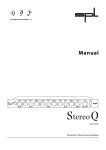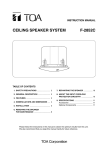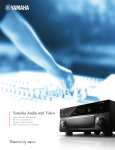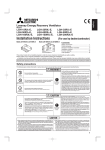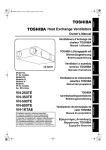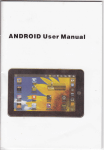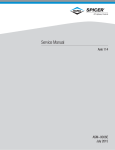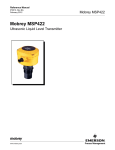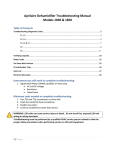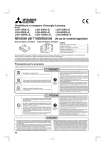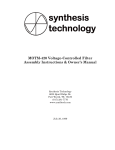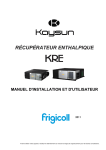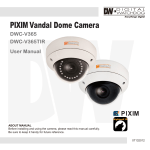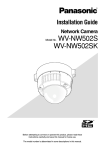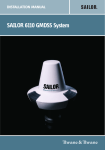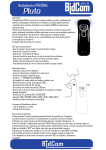Download VN-250TE VN-350TE VN-500TE VN-800TE VN-1KTAE
Transcript
FILE NO. A06-003 SERVICE MANUAL HEAT EXCHANGE VENTILATORS VN-250TE VN-350TE VN-500TE VN-800TE VN-1KTAE VN-500TE PRINTED IN JAPAN, Mar.,2006 ToMo CONTENTS 1. SAFETY CAUTIONS ................................................................................. 3 2. TECHNICAL POINTS (PERFORMANCE) ................................................ 7 3. REFERENCE DRAWING FOR INSTALLATION ....................................... 7 4. SPECIFICATIONS ..................................................................................... 8 5. NAME AND DIMENSION OF EACH PARTS .......................................... 11 6. WIRING DIAGRAM ................................................................................. 12 7. OWNER’S MANUAL (EXTRACT) ........................................................... 13 8. INSTALLATION MANUAL (EXTRACT) .................................................. 19 9. HOW TO DIAGNOSE THE TROUBLE ..................................................... 24 10. HOW TO REPLACE THE MAIN PARTS .................................................. 25 11. CHECK WHEN REPAIR WORK COMPLETED....................................... 28 12. Q & A FOR HEAT EXCHANGE VENTILATORS ..................................... 29 13. EXPLODED VIEWS AND PARTS LIST .................................................. 30 –2– 1. SAFETY CAUTIONS The important contents concerned to the safety are described on the ventilator body and in this Service manual. Preserve the described items after understanding clearly the following contents (indications/illustration symbols) and reading this manual thoroughly. n Explanation of indications Indication Meaning DANGER Indicates the contents which a danger such as death or serious injury is caused in emergency on the repair engineers or the surrounding third party by an incorrect work. WARNING Indicates the contents which a possibility such as death or serious injury is caused on the repair engineers or the surrounding third party by an incorrect work, or on the customers by a trouble of the products. CAUTION Indicates the contents which occurrence of injury (*) or damage of property is supposed on the repair engineers or the surrounding third party by an incorrect work, or on the customers by a trouble of the products. * Damage of property : expanded damage concerned to property/household effects or domestic animals/pets n Explanation of illustration symbols Illustration symbol Meaning Indicates prohibition (Never do it.). The concrete contents of prohibition are indicated with illustrations or descriptions near the illustration symbol. Indicates forced work (Necessarily do it.). The concrete contents of forced work are indicated with illustrations or descriptions near the illustration symbol. Indicates cautions (including danger/warning). The concrete contents of cautions are indicated with illustrations or descriptions near the illustration symbol. 1-1. Warning and Caution Exclusive in Service Work WARNING • Be sure to ask the customers not to let children close to the work place. The tools or disassembled parts may cause an injury on children. • Be sure to turn off the breaker before work when power-ON is unnecessary such as a case of disassembling. If doing so, an electric shock may be caused. • Use the substitute parts corresponded to the model for repair. And do not modify the products. It causes an abnormal operation or a trouble resulted in leakage or fire, that is a cause of customers’ disaster. • For connection of the cut lead cables, connect the cables with application terminals, direct the closed end side upward, and then apply the draining process. If the post-process of connection is not carried out, a cause of customers’ disaster such as leakage or fire generates. • After the work, check the insulation resistance between live part (pin of SL terminal) and non-current carrying part (motor frame) using a insulation megger (500V) and confirm 10MW or more is kept. If the insulation resistance is not confirmed, a cause of customers’ disaster such as leakage or fire generates. CAUTION • Use the protective materials such as gloves, etc. for check/repair inside of the unit. If touching inside of the unit with bare hands, an injury may be caused. –3– 1-2. DANGER/WARNING/CAUTION Described in Owner’s Manual DANGER • Do not use as an air circulators for open-type burners (heaters). When gas or oil stoves are used in the home, separate equipment for circulating the air should be used. WARNING • When any abnormal condition (scorching smell or others) is found, stop the operation immediately and keep the exclusive circuit breaker “OFF”. If you continue the operation without removing the cause, it could cause an electric shock or a fire. • When the system needs a repair, consult your dealer. • When the system is checked and the power cable undergoes maintenance, stop the operation, and switch the exclusive circuit breaker “OFF”. The internal fan is revolving at high speeds and can cause serious injury. And when using a stepladder, etc., make sure to fix it properly. • The external air intake opening should be positioned away from the exhaust openings of combustion gases etc. The intake of such gasses could lead to a lack of oxygen in the room. • If there is combustible gas leakage from other appliances, ventilate the room by opening windows. If operation were to be attempted in such a situation, sparking at electrical contact points could cause an explosion. • Netting or something similar should be provided at the external air intake opening to prevent birds etc. interfering with the unit. Nests or other foreign objects should be removed. That could lead to a lack of oxygen in the room. • If the supply cord is damaged, it must be replaced by the manufacturer or its service agent or a similarly qualified person in order to avoid a hazard. • The external air intake opening should not be positioned where discharged air may directly enter it. A situation like this will lead to the room being contaminated and this may pose a health risk. • When Heat Exchange Ventilators are relocated, contact your dealer or a professional installer. Improper practice of installation could cause a drop of the unit, a water leakage, an electric shock or a fire. • Ask the sales office or the engineering shop to perform the work. • Don't push a finger or a stick into the open-air inlet or the exhaust outlet. A fan with a high rpm will injure you. • Modification of the system is strictly prohibited. Improper practice of repair could cause a water leakage, an electric shock or a fire. • When the system needs a repair, consult your dealer. –4– CAUTION • If Heat Exchange Ventilators are not used for a long period of time, keep the exclusive circuit breaker “OFF” for safety reasons. If the power is left on, any build-up of dust could cause a heat generation or a fire. • The system should never be used for any other purposes than intended such as for preservation of foods, flora and fauna, precision devices or work of art. • It could cause deterioration of foods or other problems. • Install at a stable place of sufficient strength. Please note that there might be some places not strong enough to install due the structure of building. • Provide an exclusive circuit breaker that can completely break contacts on all the poles by more than 3mm through direct connection to the power terminals. Depending upon the environment for installation, it becomes necessary to install an earth leakage breaker. Unless the earth leakage breaker is installed, it could cause an electric shock. • Ask the sales office or the engineering shop to perform the work. • Never fail to install the unit inside the heat insulting walls or, in other words, in the space insulated from the open air. If you install it outside or in the space equivalent to the open-air conditions, dew is condensed inside the body in the winter season. • The filter should be cleaned regularly. Dust or dirt building-up on it can lead to a lack of oxygen in the room. • Use gloves when cleaning the filter or heat exchange element. Doing so will reduce any possibility of injury. • It is strictly prohibited to place a container of combustible gas or liquid near Heat Exchange Ventilators or to spray it directly with the gas or liquid. It could cause a fire. • Do not use outside the rated voltage. It could cause a fire or an electric shock. • Combustion apparatus should not be placed allowing a direct exposure to wind of Heat Exchange Ventilators. Incomplete combustion could occur on the apparatus. • Don’t put a container of water on Heat Exchange Ventilators. When water spills, it is likely to enter inside the unit and degrade electric insulation, possibly resulting in an electric shock. • Don’t incline Heat Exchange Ventilators when taking them out. Otherwise, water remaining inside is likely to drop and wet the furniture or other property. • Ask the sales office or the engineering shop to perform the work. • Do not install in locations where harmful or corrosive gasses may be present (i.e. acidic, alkali, organic solvent, paint gasses etc. from machinery or factories) Installation in such a location could cause a gas-poisoning and a fire. • Do not install in locations where oily smoke or soot may be present. There is a possibility that oil will adhere to the filter, heat exchange element etc. and make operation impossible. • Do not install in locations with high humidity, such as close to bathroom etc. Installation in such a location could cause a breakdown. • Don’t use benzene or metal brush when cleaning the filter and heat exchange element. Otherwise, the unit will get unfit for use. • Don’t blow directly against animals or plants. Likely to cause bad effect on animals and plants. • Do not wash Heat Exchange Ventilators with water. It could cause an electric shock. • Do not handle switches with a wet hand. It could cause an electric shock. –5– 1-3. WARNING/CAUTION Described in Installation Manual WARNING Never fail to ask the sales office from which you bought the unit or the installing service shop to install the unit. If you install it by yourself, any inappropriate installing works would cause an electric shock or a fire. Carry out the installing works accurately in line with this installation manual. Improper practice of installation could cause an electric shocks or a fire. Choose the installing place where is endurable in quality as well as in weight, then install the unit accurately with adequate strength and completeness of installation in accordance with the installation manual. Otherwise, it is likely to cause an electric shock, a fire, a drop of the unit, thus causing the injury on the human body. Carry out electrical work in accordance with the laws and regulations prevailing in the country concerned, technical standard and explanation for work, and make absolutely sure that an exclusive circuit is used. Any insufficient capacity of power circuit and improper work can result in electric shock and fire hazard. The external air intake opening should be positioned away from the exhaust openings of combustion gases etc. The intake of such gases could cause a lack of oxygen in the room. Netting or something similar should be provided at the external air intake opening to prevent birds etc. interfering with the unit. Nests or other foreign objects should be removed. That could cause a lack of oxygen in the room. When the system is checked and the power cable undergoes maintenance, stop the operation, and switch the exclusive circuit breaker “OFF”. Otherwise, it could cause an electric shock. Carry out the GND work. Never connect the GND wire to a gas pipe, a water supply pipe, a lightning conductor, a GND line of a telephone, etc. An incomplete GND wire is likely to cause an electric shock. CAUTION Provide an exclusive circuit breaker that can completely break contacts on all the poles by more than 3mm through direct connection to the power terminals. Depending upon the environment for installation, it becomes necessary to install an earth leakage breaker. When you want to pierce the metal duct through the metal lath or the wire lath or the metal plate of the wooden facility, do not forget to insulate electrically between the duct and the wall. Otherwise, it would cause an electric shock or an electric leakage. Don’t use other parts than specified (including the auxiliary parts) for installing works. If you do not use the specified parts, it is likely to cause a drop of the unit, a fire, an electric shock, etc. Install the outdoor duct in a falling gradient toward the outside so as to prevent water from coming in. If it is not installed so, the building is likely to be flooded, wetting the household effects. Heat-insulate the outdoor duct (including the indoor side, if necessary) to prevent dewing. If heat insulation is not adequate, water likely goes indoor and wets the household properties. When it is high humid and high temperature inside the ceiling, a ventilation system must be installed inside the ceiling. Otherwise, it could cause a fire or an electric leakage. Connect the power line and the connecting line with accuracy using the specified cables and fix them firmly so as not to put the outer stress of the cables on the pin connecting area. Incomplete connection or fixing is likely to cause a heat generation or a fire. Install the power line and the connecting line with accuracy so the power source cover may not float. If the installation of the power source cover is inappropriate, the pin connection area is likely to cause a heat generation, a fire and an electric shock due to dust or powder. Never install the unit near the place where there is a fear of leakage of an inflammable gas. If gas happens to leak and stays around the unit, it is likely to cause a fire. Don’t use the unit at the other voltages than the rated one. It could cause a fire or an electric shock. Do not install the unit in locations with large amounts of oily smoke, such as food preparation areas. It could cause a fire. Don’t install the unit at the place of a high temperature or a flame. It could cause a heat generation or a fire. Do not install in locations where harmful or corrosive gasses may be present (i.e. acidic, alkali, organic solvent, paint gasses etc. from machinery or factories). Installation in such a location could cause a gas-poisoning and a fire. Do not install in locations with high humidity, such as close to bathroom etc. It could cause an electric shock or an electric leakage etc. –6– 2. TECHNICAL POINTS (PERFORMANCE) • Energy-saving ventilation to save the cooling/heating cost because the heat energy (outside air load) to be lost by ventilation is effectively recovered. • Compact construction to downside the cooling/heating equipment with size corresponding to heat energy amount to be recovered because the outside air load can be vastly decreased. • By using the heat exchanger, humidity control effect which sucks the humidity approached to near the humidity in the room. • Comfortable ventilation by simultaneous air suction/discharge which sucked air approached to the temperature in the room and the stable ventilation to be performed even in the high airtight room. • Noise-proof effect to prevent entering of outside noise or flowing of noise to outside. • Suction/discharge air system on straight line which is easy to be designed or installed. • The high-level long filter is mounted to increase the effect of dust collection for removing. ( Weight: 82%) • Reverse installation up and down is possible, which 2 units use the same check port. • Especially powerful notch is mounted, which can increase air volume and is selectable in the main unit. • Only one check port is used for all the maintenance works. 3. REFERENCE DRAWING FOR INSTALLATION Supply Air Duct Outside Intake Duct Ceiling Suspension Bolt Pipe Hood SA (Supply Air) RA (Outside Air) Room Intake Duct EA (Exhaust Air) OA (Outside Air) Room Intake Opening (Supply/Exhaust Air Grill) Heat Insulation Material Exhaust Air Duct Pipe Hood –7– Inside Supply Opening (Supply/Exhaust Air Grill) 4. SPECIFICATIONS <VN-250TE, VN-350TE> VN-250TE Model VN-350TE Type Concealed duct type Ventilation system Heat exchange Normal ventilation Rating Heat exchange Normal ventilation 50Hz 220 – 240V, 60Hz 220V Extra high High Extra high Low High Extra high Low High Extra high Low High Low 50Hz 0.48–0.5 0.46–0.48 0.37–0.39 0.47–0.5 0.46–0.48 0.37–0.39 0.63–0.65 0.59–0.6 0.56–0.57 0.61–0.63 0.57–0.6 0.54–0.56 Current (A) 60Hz 0.59 0.55 50Hz 104–119 99–114 0.39 79–90 0.59 0.55 0.39 103–119 98–114 0.85 79–90 0.75 0.67 0.83 0.74 0.67 137–154 124–137 117–128 133–151 119–132 113–125 Power consumption (W) Characteristics Air volume 60Hz 128 118 78 128 118 77 178 149 132 176 145 131 50Hz 250 250 170 250 250 170 350 350 280 350 350 280 60Hz 250 250 135 250 250 135 350 350 240 350 350 240 50Hz 90 80 37 90 80 37 95 65 42 95 65 42 60Hz 125 100 30 125 100 30 155 90 43 155 90 43 50Hz 27–28 26–27 21–22 27–28 31–32 29–30 25–26 31–32 30–31 26–27 60Hz 28 26 21 28 26.5 21.5 33 30 22 33 30 23 50Hz 75 75 77 — — — 75 75 77 — — — 60Hz 75 75 78 — — — 75 75 79 — — — 50Hz 70 70 73 — — — 69 69 71 — — — 60Hz 70 70 75 — — — 69 69 73 — — — 50Hz 63 63 66 — — — 66 66 69 — — — 60Hz 63 63 68 — — — 66 66 71 — — — (m³/H) Static pressure (pa) Noise 26.5–27.5 21.5–22.5 (dB) Temp. exchange rate (%) In heating Enthalpy exchange rate (%) In cooling Frame Zinc iron plate Motor 4-pole capacitor dielectric motor (E type) Construction Sirocco fan ABS resin Heat exchanger Combustion-proof sheet Filter Nonwoven fabric (Collection effect weighing method 82%) Adapter Mounting pipe diam. ABS resin (mm) External dimension (mm) (Length x Width x Height) Product mass (kg) Ø150 599 x 882 x 270 804 x 882 x 270 29 37 Package Shape Corrugated board package/ventilator Dimension (mm) (Length x Width x Height) Mass (kg) 335 x 1138 x 795 335 x 1138 x 1000 34 42 No. of stacked boxes Accessory 4 Installation Manual: 1, Owner’s Manual: 1 –8– <VN-500TE, VN-800TE> VN-500TE Model VN-800TE Type Concealed duct type Ventilation system Heat exchange Normal ventilation Rating Heat exchange Normal ventilation 50Hz 220 – 240V, 60Hz 220V Current Extra high High Low Extra high High Low Extra high High Low Extra high High Low 50Hz 0.86–0.9 0.79–0.81 0.72–0.73 0.84–0.88 0.76–0.77 0.71–0.73 1.51–1.54 1.48–1.5 1.44–1.46 1.47–1.5 1.45–1.48 1.41–1.43 60Hz 1.14 1.0 0.81 1.12 0.96 0.8 2.05 1.92 1.68 2.04 1.87 1.68 (A) 50Hz 188–214 169–188 151–166 184–210 161–182 145–164 316–347 309–329 302–327 309–337 300–325 297–316 Power consumption (W) Characteristics Air volume 60Hz 244 202 162 243 196 161 424 391 347 417 387 346 50Hz 500 500 370 500 500 370 800 800 650 800 800 650 60Hz 500 500 310 500 500 310 800 800 575 800 800 575 50Hz 105 70 38 105 70 38 140 110 70 140 110 70 60Hz 165 85 33 165 85 33 190 100 50 190 100 50 50Hz 33–34 31–32 25–26 34–35 32–33 26.5–27.5 38–39 36.5–37.5 32–34 38.5–39.5 37–38 33–35 60Hz 35 31 23 36 33 24 39 36 31 39.5 37 31 50Hz 75 75 77 — — — 75 75 76 — — — 60Hz 75 75 79 — — — 75 75 77 — — — 50Hz 67 67 71 — — — 71 71 74 — — — 60Hz 67 67 74 — — — 71 71 75 — — — 50Hz 62 62 67 — — — 65 65 68 — — — 60Hz 62 62 69 — — — 65 65 69 — — — (m³/H) Static pressure (pa) Noise (dB) Temp. exchange rate (%) In heating Enthalpy exchange rate (%) In cooling Frame Zinc iron plate Motor 4-pole capacitor dielectric motor (E type) Construction Sirocco fan ABS resin Heat exchanger Combustion-proof sheet Filter Nonwoven fabric (Collection effect weighing method 82%) Adapter Mounting pipe diam. Zinc iron plate (mm) External dimension (mm) (Length x Width x Height) Product mass (kg) Ø200 Ø250 904 x 962 x 270 884 x 1322 x 388 43 71 Package Shape Corrugated board package/ventilator Dimension (mm) (Length x Width x Height) Mass No. of stacked boxes Accessory (kg) 335 x 1218 x 1100 453 x 1538 x 1075 48 79 4 3 Installation Manual: 1, Owner’s Manual: 1 –9– <VN-1KTAE> VN-1KTAE Model Type Concealed duct type Ventilation system Heat exchange Characteristics Rating 50Hz 220 – 240V Extra high High Low Extra high High Low Current (A) 1.97–2.04 1.85–1.93 1.68–1.76 1.95–2.03 1.84–1.92 1.67–1.74 Power consumption (W) 399–445 360–399 332–367 392–438 358–392 329–362 1000 1000 810 1000 1000 810 Air volume (m²/H) Static pressure (pa) 90 55 35 90 55 35 Noise (dB) 37.5–38.5 36–37 31–33 38–39 36.5–37.5 31.5–33.5 (%) 75 75 76 — — — In heating 71 71 73 — — — In cooling 65 65 68 — — — Temp. exchange rate Enthalpy exchange rate (%) Frame Zinc iron plate Motor 4-pole capacitor dielectric motor (E type) Construction Sirocco fan ABS resin Heat exchanger Combustion-proof sheet Filter Nonwoven fabric (Collection effect weighing method 82%) Adapter Zinc iron plate Mounting pipe diam. (mm) Ø250 External dimension (Length x Width x Height) (mm) 1134 x 1322 x 388 (kg) 83 Product mass Shape Package Normal ventilation Dimension (Length x Width x Height) Mass Corrugated board package/ventilator (mm) 453 x 1538 x 1325 (kg) 91 No. of stacked boxes Accessory 3 Installation Manual: 1, Owner’s Manual: 1 – 10 – 5. NAME AND DIMENSION OF EACH PARTS <VN-250TE, VN-350TE, VN-500TE> Number 2 6 5 9 10 Name Quantity Note 1 Frame 1 2 Adapter 4 3 Terminal 1 4 Inspection Cover 1 5 Fan Sirocco 2 6 Motor Fan 2 7 Heat Exchanger 2 8 Filter 2 9 Damper 1 10 Motor Damper 1 11 Ceiling Suspension Fixture 4 12 Electric Parts Lid 1 J E EA (Exhaust Air) F I A RA (Room Air) OA (Outside Air) G H SA (Supply Air) 1 11 7 K L 4-13 x 30 Oval Hole M N P B C 8 12 3 Note) Model VN-250TE has one Heat Exchange. Applicable Duct C 4 Note) Model Nominal Diameter VN-250TE Ø150 VN-350TE Ø200 VN-500TE Unit: mm Model A B C E F G H I J K L M N P VN-250TE 599 882 95 810 655 19 142 315 142 135 159 270 Ø144 Ø164 VN-350TE 804 882 95 810 860 19 162 480 162 135 159 270 Ø144 Ø164 VN-500TE 904 962 107 890 960 19 202 500 202 135 159 70 Ø194 Ø210 <VN-800TE, VN-1KTAE> 6 8 10 9 H E EA (Exhaust Air) F RA (Room Air) I A 1 Frame 1 2 Adapter 4 3 Terminal 1 4 Inspection Cover 1 5 Fan Sirocco 2 6 Motor Fan 2 7 Heat Exchanger 3 G 5 Quantity Note Name Number 2 OA (Outside Air) Note) G H SA (Supply Air) 7 Filter 2 9 Damper 1 L 10 Motor Damper 1 11 Ceiling Suspension Fixture 4 12 Electric Parts Lid 1 4-13 x 30, Oval Hole P B M N 1 11 8 K M+2 J Note) Model VN-1KTAE has one Heat Exchange. Applicable Duct C C 4 Model 3 Nominal Diameter VN-800TE 12 Ø250 VN-1KTAE Unit: mm Model A B C E F G H I J K L M N P VN-800TE 884 1322 85 VN-1KTAE 1134 1322 85 1250 940 19 228 428 612 194 218 388 Ø245 Ø258 1250 1190 19 228 678 612 194 218 388 Ø242 Ø258 – 11 – 6. WIRING DIAGRAM <VN-250TE, VN-350TE, VN-500TE> Damper Motor Red Capacitor Capacitor Orange CN– SAFM Divide the power lines running to the switch and the main unit. On the product. do not attach more then one cable to each terminal. Yellow Blue Low High Whte Extra High Black Common Black Common 1 2 3 4 5 6 7 1 2 3 4 5 6 7 8 1 2 3 4 5 6 7 CN– 1 2 3 4 5 6 7 8 EAFM 1 2 3 4 5 1 2 3 4 5 CN–DM NC 4 3 (Heat Exchange) Power Source Whte Extra High Yellow Yellow Blue Low High Blue MS Orange Black Exhaust Air Fan White (Normal) Red Supply Air Fan NO RY4 CM 1 1 (LINE) CN8 CN7 CN6 CN5 (NEUTRAL) RY4 NO NC NO (1) NO RY5 RY3 CM (2) VN-350TE Power Source 220-240V~50Hz/ 220V~60Hz VN-500TE RY5 Operation Switch (1) 0 (OFF) (2) 1 (ON) 1 TM1 L 2 N 3 COMMON 4 LOW 5 HIGH 6 DAMPER 7 (3) (4) Air Flow Switch (3) High (4) Low (5) (6) Function Select Switch (5) Heat Exchange Ventilation (6) Normal Ventilation To find out the function of each switch. Model VN-250TE CM RY2 CM RY3 NC Switch (To be procured locally) RY2 (Srcond main body) Model 1 TM1 L 2 N 3 4 LOW 5 HIGH 6 DAMPER 7 Power Source Capacitor VN-250TE 2.0µF 450VAC VN-350TE 3.0µF 450VAC VN-500TE 3.5µF 450VAC Third main body <VN-800TE, VN-1KTAE> Damper Motor Red Capacitor Power Source CN– SAFM Divide the power lines running to the switch and the main unit. On the product. do not attach more then one cable to each terminal. Whte Extra High Yellow Blue Low High Whte Extra High Black Common Black Common 1 2 3 4 5 6 7 1 2 3 4 5 6 7 8 1 2 3 4 5 6 7 CN– 1 2 3 4 5 6 7 8 EAFM 3 Blue Yellow Blue Low High Yellow MS Orange Black Capacitor Orange White (Normal) Exhaust Air Fan (Heat Exchange) Red Supply Air Fan 1 2 3 4 5 1 2 3 4 5 CN–DM NC 4 NO RY4 CM (LINE) 1 1 CN8 CN7 CN6 CN5 RY4 (NEUTRAL) NO RY3 NC NO (1) NO RY2 RY5 CM CM NC CM NO RY1 (3) (5) (6) Function Select Switch (5) Heat Exchange Ventilation (6) Normal Ventilation To find out the function of each switch. Model Power Source VN-800TE 220-240V~50Hz/ 220V~60Hz VN-1KTAE 220-240V~50Hz/ CM 1 TM1 L 2 N 3 COMMON 4 LOW 5 HIGH 6 DAMPER 7 (4) Air Flow Switch (3) High (4) Low RY1 NC (2) Operation Switch (1) 0 (OFF) (2) 1 (ON) RY3 Switch (To be procured locally) RY5 RY2 (Srcond main body) 1 TM1 Power Source Model L 2 N 3 COMMON 4 LOW 5 HIGH 6 DAMPER 7 Third main body – 12 – Capacitor VN-800TE 8.0µF 450VAC VN-1KTAE 10.0µF 450VAC 7. OWNER’S MANUAL (EXTRACT) 7-1. Specific Caution Items 7-1-1. Checking Location of Installation This Energy Recovery Ventilators have been designed especially for use in offices, conference rooms, etc. Please check to ensure that neither the main unit nor the inlet-outlet grill are installed in any of the following locations. Locations exposed to high temperatures or direct flame. Avoid installing the Heat Exchange Ventilators or the inlet-outlet grill in locations which reach temperatures of 40°C or above. Locations with high humidity. Do not install in high humidity locations such as bathrooms. Doing so may cause a breakdown of the unit or an electric shock. Locations with large amounts of oily smoke, such as food preparation areas. The unit will become inoperable if the filter or Heat Exchanger become clogged with oil. Usage under high temperature conditions may cause distortion of the filter or Heat Exchanger or motor burn-out. Interior Intake Vent 40˚C Oily smoke Make sure that access is provided so that filter and Heat Exchanger maintenance and periodic spot checks of the unit can be easily carried out. (Refer to the Model Installation for its space) Do not install the unit in locations such as machinery or chemical plants where it will be exposed to noxious gases containing acids, alkali, organic solvents, paint fumes, etc., to gases containing corrosive ingredients, or where dust or oil mist will be produced. If there are any problems concerning the location or installation of the unit, please consult either store from which it was purchased or the agent who installed it. 7-1-2. When Using Always be sure to use a filter. Operate the switch with certainty. Failure to do so may cause dust and dirt to build up on the heat exchange element, lowering its efficiency and rendering it inoperable. In particular, suddenly turning the switch on and off will not only cause improper operation of the unit, but will also obversely affect the relay inside the switch, and may damage it. – 13 – 7-2. Model Installation Supply Air Duct Outside Intake Duct Ceiling Suspension Bolt Pipe Hood SA (Supply Air) Note that when installing a unit body upside down, its printed indication is in a reversed position. RA (Outside Air) Room Intake Duct EA (Exhaust Air) Room Intake Opening OA (Outside Air) 7-2-1. Method of Use (Supply/Exhaust Air Grill) Heat Insulation Material Exhaust Air Duct Inside Supply Opening (Supply/Exhaust Air Grill) • Use the operation switch to operate the unit. Pipe Hood 0 (OFF) .............. the unit stop. 1 (ON) ............... the unit operates. • Use the Air Flow switch to set to the desired air flow. High ................... Turns to high air volume. Low .................... Turns to low air volume. • Use the Function Select switch to set the ventilation mode. Heat Exchange Ventilation Mode ..... Open air is thermal-exchange with room air to bring it closer to a room temperature and humidity, before taking it in the room. Normal Ventilation Mode ................. To intake open air as it is. 7-3. Maintenance Method In order to prevent the reduced effectiveness of your Heat Exchange Ventilators, be sure to clean dirt and dust from the filter and Heat Exchanger at regular intervals. CAUTION Be sure to turn the power off, and to keep the exclusive breaker off before carrying out maintenance activities. Do not immerse the filter or other resin components in water 60°C or above. Never use water on the motor, the switch, or the Heat Exchanger. Switch Turn off Motor Wa or ater 60˚ bov C e Do not use the following items for cleaning. Switch Avoid using heat to dry the filter, as it may cause changes in shape or quality. Benzene Gasoline Thinner Filter Metal brush – 14 – Heat Exchange Element Always be sure to use a filter. Failure to do so may cause dust and dirt to build up on the Heat Exchanger, lowering its efficiency and rendering it inoperable. 7-4. Maintenance Method 7-4-1. Model VN-250TE/VN-350TE/VN-500TE Hook • Stop the operation and keep the exclusive breaker “OFF”. Inspection Cover • Cleaning the filter (When required) 1) Enter the ceiling from the Inspection Opening for the Heat Exchange Ventilators, and remove the screw on the inspection cover. 2) Holding the Inspection Cover, turn two pieces of knob for 90° and remove the cover. 3) There is a filter below the Heat Exchanger at two places, respectively. Pull it toward you. 4) Either lightly strike the removed filter with your hand or vacuum it with a vacuum cleaner to remove the dirt. If it is very dirty, swish it back and forth in a solution of lukewarm water and dish-washing (neutral) detergent. 5) Install the filter after thoroughly allowing it to dry naturally. CAUTION Hook Inspection Cover Knob Position Avoid using heat to dry the filter, as this may cause changes in the shape or quality of the filter. When installed (Closed) To remove (Open) • Whenever the filter was damaged, order the sales shop or the engineering office. (Separately sold) • Cleaning the Heat Exchanger. (If you find it too much stained, clean it.) 1) Remove the filters. 2) Remove the two Heat Exchanger from the unit. (Model VN-250TE has one Heat Exchange.) Filter CAUTION • The weight of the Heat Exchanger is as shown in the table below. Hold it firmly to ensure that you do not drop it. Model Weight (kg/piece) Pieces to be used VN-250TE 4.5 1 VN-350TE 3.4 2 VN-500TE 3.7 2 – 15 – Heat Exchanger 3) Use a vacuum cleaner to remove dust and dirt from the element’s surface. CAUTION • Use a brush attachment on the vacuum cleaner nozzle. Clean with a light, brushing action. Avoid using a hard nozzle as it may disfigure the heat exchange foils. • Never use water to clean the Heat Exchanger. • Whenever the Heat Exchanger was damaged, order the sales shop or the engineering office. (Separately sold) 4) When cleaning is completed, return the Heat Exchanger and filter to their former positions, and close the Inspection cover and tighten the screw. CAUTION • Make absolutely sure to install the filter with an indication of “ ” turned to wart the Heat Exchanger side. Failure to do so will lead to clogging of the Heat Exchanger foils and reduced performance. • Insert the heat exchanger right side up, with the label marked ñ facing toward you. – 16 – Nozzle Mark 7-4-2. Model VN-800TE/VN-1KTAE • Stop the operation and keep the exclusive breaker "OFF". • Cleaning the filter (When required) 1) Enter the ceiling from the Inspection Opening for the Heat Exchange Ventilators, and remove the screw on the inspection cover. 2) Holding the Inspection Cover, turn two pieces of knob for 90° and remove the cover. 3) There is a filter at two places, respectively. Pull it toward you. 4) Either lightly strike the removed filter with your hand or vacuum it with a vacuum cleaner to remove the dirt. If it is very dirty, swish it back and forth in a solution of lukewarm water and dish-washing (neutral) detergent. 5) Install the filter after thoroughly allowing it to dry naturally. (Install them to fit well with the grooved rail) Hook Inspection Cover Hook Inspection Cover CAUTION Knob Position Avoid using heat to dry the filter, as this may cause changes in the shape or quality of the filter. When installed (Closed) • Whenever the filter was damaged, order the sales shop or the engineering office. (Separately sold) Filter • Cleaning the Heat Exchanger. (If you find it too much stained, clean it.) 1) Remove the four Heat Exchanger from the unit. (Model VN-800TE has three Heat Exchange.) CAUTION • The weight of the Heat Exchanger is as shown in the table below. Hold it firmly to ensure that you do not drop it. Model Weight (kg/piece) Pieces to be used VN-800TE 4.0 3 VN-1KTAE 4.0 4 – 17 – Grooved Rail Heat Exchanger To remove (Open) 2) Use a vacuum cleaner to remove dust and dirt from the element's surface. CAUTION • Use a brush attachment on the vacuum cleaner nozzle. Clean with a light, brushing action. Avoid using a hard nozzle as it may disfigure the heat exchange foils. • Never use water to clean the Heat Exchanger. • Whenever the Heat Exchanger was damaged, order the sales shop or the engineering office. (Separately sold) 3) When cleaning is completed, return the Heat Exchanger and filter to their former positions, and close the Inspection cover and tighten the screw. Nozzle CAUTION • Make absolutely sure to install the filter with an indication of “ ” turned toward the Heat Exchanger side. Failure to do so will lead to clogging of the Heat Exchanger foils and reduced performance. • Please insert so that the stamp “ ” to be toward you. Stamp 7-5. After-sales Service • Request for Spot Checks To ensure safe, correct usage, we suggest that you consider a maintenance contract. For details, inquire at the store where you bought your unit, or at the agent which installed it. • If You Think It’s Broken Examine the unit as shown in the table below, and if you find any irregularities, shut it off immediately and contact the store where you bought your unit or the agent who installed it to request servicing (or consultation). Symptom Where to look • No activity, even when the switch is on. • Is the fuse blown or the breaker tripped? • No air comes out. • Check whether or not there is dust on the filters and the Heat Exchanger. (Clean it according to the Maintenance Method mentioned.) • Is the power out? – 18 – 8. INSTALLATION MANUAL (EXTRACT) 8-1. Cautions for Operation Never fail to make the inspection opening at the specific place on the ceiling so you can perform the constant cleaning or the equipment checking of filter and Heat Exchanger. • The inspection opening shown below is necessary to clean the Heat Exchanger and the filter as required. If not cleaned, they are likely to get clogged, resulting in degradation of performance. A RA (Room Air) A 600 SA (Supply Air) 600 RA (Room Air) Unit Body SA (Supply Air) Unit Body Maintenance Space Maintenance Space Inspection Opening : 450 EA (Exhaust Air) OA (Outside Air) Inspection Opening : 450 EA (Exhaust Air) (For the inspection of Filters, Heat Exchanger, Fans, Motors and Damper.) Heat Exchanger OA (Outside Air) Heat Exchanger Note) Model VN-250TE has one Heat Exchange. (For the inspection of Filters, Heat Exchanger, Fans, Motors and Damper.) Note) Model VN-1KTAE has four Heat Exchange. Unit : mm Unit : mm Model A Model A VN-250TE 599 VN-800TE 884 VN-350TE 804 VN-1KTAE 1134 VN-500TE 904 • This Energy Recovery Ventilators should be installed at the place where a larger space than the sizes shown below can be secured for the ceiling space. 20 Unit : mm Model Ceiling Space A Model Ceiling Space A VN-800TE A VN-250TE VN-350TE 320 VN-1KTAE 440 VN-500TE • Don't install it near the water-heater. • Refrain from the following duct installing works. (1) Excessive bending (2) Multi-times bending – 19 – (3) Making the connecting duct smaller • Do not use in bathrooms or food preparation areas etc. If you use the unit at the place of much soot and high humidity, the filter or the Heat Exchanger gets clogged and disables you to use it. • Be careful of dewing and frosting. As shown in the figure to the right, suppose a high temp. absorbing air condition A and a low temp absorbing air condition B are plotted on the air line figure, then a high temp air A is heat-exchanged by the unit and goes out of the saturation curve as shown by Point C. In this case, the unit will be dewed or frosted. To avoid this, you are required to heat a low temp air B up to B' so as to get C' below the saturation curve, before using the unit. A Saturation curve C C' B B' Absolute humidity (kg/kg’) • Use the Heat Exchange Ventilators in the ambient temperature of 40°C or less. Never install the unit at the place where the flame likely reaches directly the unit. If you use it at the atmosphere of more than 40°C for hours, it is likely to cause deterioration or deformation or damage of the resin part. Dry-bulb temperature (˚C) 8-2. Local Procurements • Switches are to be locally procured. We recommend that you use a switch having more than 3mm distance to break contact and more than 15A rated current. 8-3. Reference Sketch Supply Air Duct Outside Intake Duct Ceiling Suspension Bolt Pipe Hood SA (Supply Air) RA (Outside Air) Room Intake Duct EA (Exhaust Air) OA (Outside Air) Room Intake Opening (Supply/Exhaust Air Grill) Heat Insulation Material Exhaust Air Duct Inside Supply Opening (Supply/Exhaust Air Grill) Pipe Hood Use conditions Outdoor air conditions : Temperature range –10°C~40°C, relative humidity 85% or less Indoor air conditions : Temperature range –10°C~40°C, relative humidity 85% or less Installation requirements: Same as the indoor air conditions • Indoor air here means air in air-conditioned living rooms. Its use in refrigerators or other places where temperature can fluctuate greatly is prohibited even if a temperature range is acceptable. Example: Indoor air conditions During cooling period : Temperature 27°C, relative humidity 50% During heating period : Temperature 20°C, relative humidity 40% – 20 – 8-4. Installation Method 8-4-1. Model Installation • You are required to prepare the ceiling suspension bolts, nuts and washers. • Install the unit firmly and horizontally enough to support its weight. (Fig. 1) • If you do not fit it firmly, it is not only dangerous but also easily vibrated. If it is not fitted horizontally, the damper unit becomes defective in operation. CAUTION Nut Washer Ceiling Suspension Fixture Washer Nut Ceiling Suspension Bolt (Ø10 to Ø12) • When you are required to be cautious on prevention of vibration, we recommend you to use the anti-vibration ceiling suspension fixtures. • Never fail to make an inspection opening with 450 mm or more at the place shown on the paragraph of “Cautions For Operation”, so that you can inspect filters, Heat Exchanger, power source and motors. Fig. 1 8-4-2. Cautions on Installing The Unit Body Upside Down • Re-fit the ceiling suspension fixture in an opposite side. (If they are left as it is, the foolproof function of ceiling suspension bolts do not work and will cause the danger of dropping of the unit.) • Printed indication is in a reversed position. In particular, be careful of the arrow mark [ ñ ] showing the direction of inserting a Heat Exchange. 8-5. Electric Works Have a specialized working contractor perform wiring in accordance with the laws and regulations of the country concerned. • Connect the broken lines in the wiring diagram. • We recommend that you use a switch having more than 3 mm distance to break contact and more than 15A rated current. Damper Motor Red Capacitor Power Source CN– SAFM Divide the power lines running to the switch and the main unit. On the product. do not attach more then one cable to each terminal. Whte Extra High Yellow Blue Low High Whte Extra High Black Common Black Common 1 2 3 4 5 6 7 1 2 3 4 5 6 7 8 1 2 3 4 5 6 7 CN– 1 2 3 4 5 6 7 8 EAFM 1 2 3 4 5 1 2 3 4 5 CN–DM NC 4 3 Blue Yellow Blue Low High Yellow MS Orange Black Capacitor Orange White (Normal) Exhaust Air Fan (Heat Exchange) Red Supply Air Fan NO RY4 CM 1 1 (LINE) CN8 CN7 CN6 CN5 (NEUTRAL) RY4 NO NO (1) NC NO RY5 CM RY3 NC RY3 CM (2) Operation Switch (1) 0 (OFF) (2) 1 (ON) VN-500TE 1 TM1 L 2 N 3 COMMON 4 LOW 5 HIGH 6 DAMPER 7 (3) (5) (6) Function Select Switch (5) Heat Exchange Ventilation (6) Normal Ventilation To find out the function of each switch. VN-350TE Power Source 220-240V~50Hz/ 220V~60Hz RY5 (4) Air Flow Switch (3) High (4) Low Model VN-250TE CM RY2 Switch (To be procured locally) RY2 (Srcond main body) Power Source Model 1 TM1 2 3 4 LOW 5 HIGH 6 DAMPER 7 L N Third main body – 21 – Capacitor VN-250TE 2.0µF 450VAC VN-350TE 3.0µF 450VAC VN-500TE 3.5µF 450VAC Damper Motor Red Capacitor Power Source CN– SAFM Divide the power lines running to the switch and the main unit. On the product. do not attach more then one cable to each terminal. Yellow Blue Low High Whte Extra High Whte Extra High Black Common Black Common 1 2 3 4 5 6 7 1 2 3 4 5 6 7 8 1 2 3 4 5 6 7 CN– 1 2 3 4 5 6 7 8 EAFM 3 Blue Yellow Blue Low High Yellow MS Orange Black Capacitor Orange White (Normal) Exhaust Air Fan (Heat Exchange) Red Supply Air Fan 1 2 3 4 5 1 2 3 4 5 CN–DM NC 4 NO RY4 CM (LINE) 1 1 CN8 CN7 CN6 CN5 RY4 (NEUTRAL) NO RY3 NC NO (1) NO RY2 RY5 CM CM NC CM NO RY1 NC (2) RY3 RY1 Model Power Source VN-800TE 220-240V~50Hz/ 220V~60Hz VN-1KTAE 220-240V~50Hz CM Operation Switch (1) 0 (OFF) (2) 1 (ON) 1 TM1 L 2 N 3 COMMON 4 LOW 5 HIGH 6 DAMPER 7 (3) (4) Air Flow Switch (3) High (4) Low (5) (6) Function Select Switch (5) Heat Exchange Ventilation (6) Normal Ventilation To find out the function of each switch. Switch (To be procured locally) RY5 RY2 (Srcond main body) 1 TM1 Power Source Model L 2 N 3 COMMON 4 LOW 5 HIGH 6 DAMPER 7 Capacitor VN-800TE 8.0µF 450VAC VN-1KTAE 10.0µF 450VAC Third main body • Use the polyvinyl chloride insulated and sheathed cables for fixed wiring having 1.6 mm to 2.0 mm in diameter or 2.0 mm² to 3.1 mm² in conformity with IEC 60227-4. (Carry out the work based on the laws, regulations and technical standards of the country concerned.) • Follow the following steps for wiring. • Unfasten two cover-fixing screws of the electrical equipment box, open the box cover, and then connect wiring firmly. • Fit the cables from the terminal firmly with a cord clamber. Ring terminal Secure wire properly Stranded wire • When you need much airflow or a duct is long, change the wire connection from High to Extra High. • Unfasten two cover-fixing screws of the electrical equipment box and open the box cover. • Change CN6 to CN5 and CN8 to CN7 inside the Electric Parts Lid. • It is possible to operate up to 10 units from one switch set. Switching Connector (CN8) (CN8) (CN8) Cover-fixing screws of the Electric Parts Lid Electric Parts Lid (CN8) CAUTION • Use the power source corresponding to the name plate. Using a different power source may cause the motor to burn out. • Carry out grounding work according to the laws and regulations of the country concerned and the technical standard. • After completion of wiring, check again there are no wrong wirings before power ON. – 22 – 8-6. Duct Installation • • • • Wind the junction of an adaptor and a duct with an aluminum tape firmly to prevent any air leakage. The room intake opening should be positioned as far as possible from the inside supply opening. Use the specified ducts. (See the Name and Dimension of Each Part.) Install two outdoor ducts so they will be in the down gradient toward outside to prevent water from coming in. (Gradient: 1/100~1/50) (Fig. 2) • Never fail to heat-insulate two outdoor ducts (including outside air and exhaust air duct) to prevent dewing. (Material: Glass Wool, Thickness-25mm) (Fig. 2) • When you want to pierce the metal duct through the metal lath or the wire lath or the metal plate of the wooden facility, do not forget to insulate electrically between the duct and the wall. (Refer to the laws and regulations of the country concerned and the technical standard.) Heat Insulation Material (Insulate the Adapter and Aluminum Tape.) Outside Intake Duct, Exhaust Air Duct Gradient (1/100 ~ 1/50) Aluminum Tape Aluminum Tape Fig. 2 8-7. Pilot Running • On completion of installing works, never fail to check wirings and perform a pilot running. • After completion of wiring, power ON and perform a pilot run according to the following steps for checking a airflow condition and a damper operation. • Check the opening and closing of a damper by opening the inspection cover of the side of the unit. • Model VN-800TE, VN-1KTAE, two Fan Motors are stopped during an operation of the damper. Each switch setting Function Select Switch Checking items Air Flow Switch High (Extra High) 1 Heat Exchange Low High (Extra High) 2 Normal Ventilation Airflow condition Damper Check if the air from inside supply opening and the one from room intake opening are set to High (Extra High) and to Low, respectively Open (A Damper is beyond) Low Close (A Damper is near) • In case that any abnormality occurs in a pilot running, its conceivable cause would be a wrong wiring. Don’t lose time to switch the exclusive breaker to OFF and re-wire correctly. Otherwise, it is likely to cause an electric shock. – 23 – 9. HOW TO DIAGNOSE THE TROUBLE <VN-250TE, VN-350TE, VN-500TE, VN-800TE, VN-1KTAE> Phenomenon Motor fan does not revolve. Check point Cause Measures • Wall switch Connection failure, Incorrect connection • Replace wall switch. Correct connection. • Lead wire Wire disconnection • Replace motor fan. • Connecting section Contact failure • Connect surely. (Assembly of electric parts stool, Fan) • Motor fan Motor revolution section (Bearing) is locked. • Replace motor fan. Motor winding or temp. fuse is disconnected. Abnormal sound is heard from inside the main unit. • Turning section of fan sirocco Turning section of fan sirocco is locked. • Remove locked part. • Capacitor Capacitor trouble • Replace capacitor. • Relay Relay trouble • Replace relay. • Power supply Abnormal power is applied. • Check power supply. • Terminal block of wall (Assembly of electric parts stool) Miswiring • Re-wire according to the wiring diagram. • Motor fan Electromagnetic sound (Buzzing of motor) • Replace motor fan. Bearing failure • Fan sirocco Incomplete attachment of fan sirocco • Attach fan sirocco firmly. Suction of foreign matter • Remove foreign matter. Deformed fan sirocco • Replace fan sirocco. • Screws of each part of main unit Loosening of screw (Resonance due to incomplete tightening) • Tighten screw firmly. • Filter Clogging of filter • Clean filter. • Heat exchanger Clogging of heat exchanger • Clean heat exchanger Motor fan revolution is weak. • Capacitor Capacitor failure • Replace capacitor. Damper does not open/ close. • Wall switch Contact failure • Ensure contact. • Lead wire Contact failure • Ensure contact. • Motor damper Winding of motor damper is disconnected. • Replace motor damper. • Damper Catching at sliding section • Correct catching. • Connector assembly Contact failure • Replace connector assembly. – 24 – 10. HOW TO REPLACE THE MAIN PARTS WARNING Turn off the power supply. • Be sure to turn off the power supply of distribution panel, power board, and etc. before the work when power-ON is unnecessary such as a case of disassembling. Otherwise an electric shock may be caused even if the wall switch is turned off because it is a single cut switch. • Do not modify the product. Also do not use the disassembled, modified or repaired parts. Otherwise it causes a fire, electric shock or injury. Prohibition of modification. • Use the substitute parts corresponded to the model for repair. It causes an abnormal operation or a trouble resulting in leakage or fire, that is a cause of customers’ disaster. Use appropriate repair parts. CAUTION • Use the protective materials such as gloves, etc. for check/repair inside the unit. If touching inside the unit with bare hands, an injury may be caused. Use gloves. – 25 – Position/Part Replace/Assembly procedure Description WARNING Turn off the power supply. • Filter 1), 2) • Heat exchanger 1), 3) • Fan sirocco 1) to 8) • Motor fan 1) to 9) • Damper 1), 2), 3),10), 11) • Capacitor 12), 13), 14), 15) • P.C. board assembly (including terminal block and relay) 12) to 16) • Be sure to turn off the power supply of distribution panel, power board, and etc. before the work when power-ON is unnecessary such as a case of disassembling. Otherwise an electric shock may be caused even if the wall switch is turned off because it is a single cut switch. 1) Remove the screw, turn the lock knob by 90°, and then remove the lid maintenance. The figure is for VN-250TE. The configuration differs according to the model. Lid maintenance Lock knob Screw 2) Remove the filter. 3) Remove the Heat Exchanger. Heat Exchanger The weight of the heat exchanger is 3 to 7kg. Hold the Heat Exchanger hard without dropping it. Filter 4) Remove the screw and the rail. 5) Remove the partition board. Screw Partition board Rail 6) Remove the connector. 7) Remove the screw fixing the fan unit. Connector Fan unit Screw 8) Remove the nut and the fan sirocco. Nut Fan sirocco – 26 – Position/Part Replace/Assembly procedure Description 9) Remove the screw fixing the motor fan to remove the motor fan. Screw Motor fan 10) Remove the connector of the damper ass’y. 11) Remove the fixing screw of the damper ass’y and slide the damper leftward to remove it. Damper Screw Connector Damper ass’y disassembling Cam Limit switch 12) Remove the screw of the lid electric parts. Motor damper Screw Lid electric parts 13) Open the lid electric parts. 14) Remove FASTON terminal connected to the capacitor. 15) Remove the screw to remove the capacitor. 16) Remove the connector and P.C. board ass’y. Perform wiring correctly according to the wiring diagram. Mounting Perform mounting in the reverse procedure of removal. – 27 – Screw FASTON terminal P.C. board ass’y Capacitor 11. CHECK WHEN REPAIR WORK COMPLETED WARNING • After repair work, check whether there is a trouble or not referring to the check points. If the check is not performed, a fire, an electric shock or an injury occurs. Before check, turn off the power supply of the distribution panel and power board. Check after repair work Check after reinstallation • After repair work, perform a test run to check whether there is smoke/ abnormal sound or not. If the check is not performed, a fire, an electric shock or an injury occurs. • After reinstallation, check the following items. • The earth wire is correctly connected. • The power supply cord is not pinched in the product. • The installation is stable without inclination or wavering. If the check is not performed, a fire, an electric shock or an injury occurs. [Check Point] When the product was repaired (replacement of parts, etc.), be sure to perform a test run and check there is no trouble on the following items. Item Check/Judgment (1) Insulation resistance When measuring the insulation resistance between the common pin of the terminal and the metal section of the main unit under condition that the power supply cord is not connected, the insulation resistance keeps 10MΩ or more. Especially check the following cases sufficiently. • When the electric parts were replaced. • Articles used at place with high humidity. • Products used for 5 years or more. (2) Parts specified to safety If a part other than specified part is used, replace it with the specified one. (3) Process on lead wire Check whether there is slack or excessive tension of the lead wire or not. Check the lead wire is connected firmly and the binding process is surely performed. (4) Tightening of screws Check the screws are surely tightened. (5) Removal of foreign matters in the unit Check whether soldering chip, wire wastes, screws, and etc. are remained or not in the unit. And check there is no accumulation of dust in the unit. (6) Check power supply cable. Check the damage of the terminal block. Check whether the specified power supply cable is used or not. (7) Check mounting status. Check strength of the product mounting section. There is no loosening of the mounting nut, etc. – 28 – Measuring device/ Sub-material DC500V megger 12. Q & A FOR HEAT EXCHANGE VENTILATORS (Users are responsible for the following contents.) Question u Fan does not operate. Answer • Is the electric wiring securely performed? For this model, the terminal block for connection of cables is provided to the side of the main unit. The connecting works between the power supply and the switch and between the switch and the main unit are performed by the special dealers. Incorrect cabling from the specified switch and the switches disables to adjust the air volume. Therefore, check the cable connection. u Fan does not ventilate (suction air). • Are not the various filters clogged with dust, etc.? Perform cleaning described in Owner’s Manual. • Is not the heat exchanger clogged with dust, etc.? Especially in case that the mounting direction of the product is incorrect (indoor side and outdoor side), dust, etc. is clogged in a short time because the indoor air and outdoor air do not pass through the filter but flow directly in the heat exchanger. SA OA RA EA indoor side Outdoor (Out air) side Air flow u Drop of heat exchange effect • u Water drops on the ceiling surface. • Does not generate the dew condensation on the heat exchanger? In the heat exchange, the temperature difference between indoor and outdoor is widened. Therefore, in the heat exchanger, the dew condensation generates according to some conditions of temperature and humidity, and the dew condensation/freezing generates according to some conditions of outdoor air. In these cases, the status returns to the original status when temperature of the outdoor air ascends and thaws. For the measures, heating of air at low-temperature side is necessary as described in Installation Manual. Are thermal insulation process applied to 2 duct pipes (Air suction OA and air discharge EA) at outdoor side? Be sure to apply thermal insulation because the temperature difference between indoor and outdoor is widened and the dew condensation may generate according to some conditions of temperature and humidity. • Is the product installed horizontally? If the product is slanted, various troubles may be caused. u Dew condensation generates on surface of the main unit. • Is not the ventilator operated with the normal ventilation in the winter season? If the ventilator is operated with the normal ventilation in the winter season, the surface of the main unit is cooled with the outdoor air resulting in dew condensation on the surface. – 29 – 13. EXPLODED VIEWS AND PARTS LIST 16,17 1,2,10 6,7,8,9 28,29,30,31,32 28,29,30, 31,32 11,12,13,14,15 16,17 1,2,10 3,4,5 23,24,25,26 43,44 33 18,19,20, 21,22 42 40,41 50 27 34,35,36,37,38 51 39 52,53 45,46,47,48,49 *Case of VN-800, VN-1KTAE – 30 – 54,55,56,57,58 Location No. Part No. Description 1 41120433 2 41120434 3 41118431 4 5 41118432 41118448 Fan, Sirocco (VN-250TE, VN-350TE) Fan, Sirocco (VN-800TE, VN-1KTAE) Adaptor (VN-250TE, VN-350TE) Adaptor (VN-500TE) Adaptor (VN-800TE, VN-1KTAE) Heat Exchanger (VN-350TE) Heat Exchanger (VN-250TE) Heat Exchanger (VN-500TE) Heat Exchanger (VN-800TE, VN-1KTAE) Fan, Sirocco (VN-500TE) Filter (VN-250TE) Filter (VN-350TE) Filter (VN-500TE) Filter (VN-800TE) Filter (VN-1KTAE) Nut, Dome Cap (VN-250TE, VN-350TE, VN-500TE) Nut, Dome Cap (VN-800TE, VN-1KTAE) Capacitor, 2MFD, 450V (VN-250TE) Capacitor, 3MFD, 450V (VN-350TE) Capacitor, 3.5MFD, 450V (VN-500TE) Capacitor, 8MFD, 450V (VN-800TE) Capacitor, 10MFD, 450V (VN-1KTAE) Damper Ass’y (VN-250TE) Damper Ass’y (VN-350TE, VN-500TE) Damper Ass’y (VN-800TE) Damper Ass’y (VN-1KTAE) Motor, Damper, AC 220–240V Motor, Fan, AC 220–240V, 50/60Hz (VN-250TE) 6 7 8 9 41114829 41114830 41114831 41114840 10 11 12 13 14 15 16 41120445 41114833 41114834 41114835 41114845 41114846 41118433 17 41118451 18 41171265 19 41171266 20 41171267 21 41171268 22 41171269 23 24 41118531 41118532 25 26 27 41118533 41118534 41179475 28 41150975 Location No. Part No. 29 41150976 30 41150977 31 41150978 32 41150979 33 34 35 36 37 38 39 40 41170448 41179476 41179477 41179478 41179479 41179480 41112561 41170449 41 41170450 42 43 41112593 41112594 44 41112595 45 46 47 48 49 50 51 52 41116889 41116890 41116891 41116892 41116893 4118S497 4118S498 4118S499 53 4118S500 54 55 56 57 58 4119B478 4119B479 4119B480 4119B481 4119B482 – 31 – Description Motor, Fan, AC 220–240V, 50/60Hz (VN-350TE) Motor, Fan, AC 220–240V, 50/60Hz (VN-500TE) Motor, Fan, AC 220–240V, 50/60Hz (VN-800TE) Motor, Fan, AC 220–240V, 50/60Hz (VN-1KTAE) Switch, Limit Wire, Ass’y (VN-250TE) Wire, Ass’y (VN-350TE) Wire, Ass’y (VN-500TE) Wire, Ass’y (VN-800TE) Wire, Ass’y (VN-1KTAE) Lid, Electric Parts P.C. Board Ass’y (VN-250TE, VN-350TE, VN-500TE) P.C. Board Ass’y (VN-800TE, VN-1KTAE) Thumbscrew Lid, Maintenance (VN-250TE, VN-350TE, VN-500TE) Lid, Maintenance (VN-800TE, VN-1KTAE) Name Plate (VN-250TE) Name Plate (VN-350TE) Name Plate (VN-500TE) Name Plate (VN-800TE) Name Plate (VN-1KTAE) Owner’s Manual Installation Manual Wiring Diagram (VN-250TE, VN-350TE, VN-500TE) Wiring Diagram (VN-800TE, VN-1KTAE) Packing (VN-250TE) Packing (VN-350TE) Packing (VN-500TE) Packing (VN-800TE) Packing (VN-1KTAE) TOSHIBA CARRIER CORPORATION 2 CHOME 12-32, KONAN, MINATOKU, TOKYO, 108-0075, JAPAN Copyright © 1999 to 2005 TOSHIBA CARRIER CORPORATION, ALL Rights Reserved. – 32 –
































